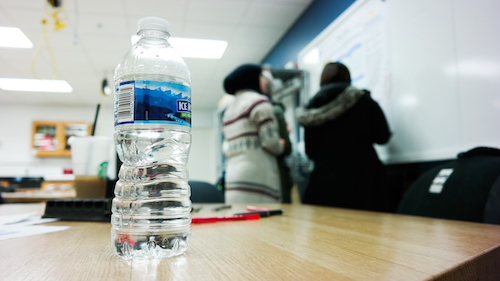
Over the past few semesters, one of education professor Chris Burke's favorite courses has been one designed to teach aspiring elementary educators about the power of science. The centerpiece of each EXPS 220 term is a hands-on project, which not only teaches core scientific principles, but aims to make a community impact. They’ve built an interesting portfolio of projects in recent years, including a car-minimizing transportation plan for the UM-Dearborn campus and a freestanding mini hydroponic garden. That last one, by the way, is still up and running in Fairlane Center South if you want to check it out.
This semester, Burke’s students turned their attention to a ripped-from-the-headlines topic: drinking water safety. Specifically, they wanted to determine just how safe the water from campus water fountains, water bottle filling stations — even the bathroom sinks — really is. Six student teams tested for several common contaminants, including lead. In addition, they ran the same tests on multiple popular bottled water brands to see how UM-Dearborn’s freely available tap water stacked up.
To many of the students, their headline conclusion — that their data demonstrated that the campus tap water is as safe as bottled water — came as a big surprise.
“Honestly, our hypothesis was we thought the bottled water would be better because you’re paying for it,” says student Jennifer Hawari. “You have this idea that when you’re paying for something you’re getting a better product. But it’s not really true.”
In all the areas the students tested — lead, copper, water hardness, organic contaminants — the UM-Dearborn tap water was just as good as bottled water. In some instances, it was actually better. In fact, one of the biggest surprises was that water from a bathroom sink faucet tested highest for overall quality. They suspect that’s likely a result of the heavy use these lines get, which regularly flushes out contaminants. “But it was still pretty shocking,” Hawari says. “If you’re thinking about safety, your first thought is not to drink water that comes from the bathroom.”
To be clear, the group is not suggesting you start filling your reusable water bottle in the bathroom. (There are obvious reasons not to do that.) But the students are making some recommendations. Part two of their project is a public awareness campaign that aims to inform students, faculty and staff about their findings. They hope the information encourages people to use reusable containers rather than relying so heavily on water in single-use plastic bottles. But most of the students say completely cutting out bottled water might be a tough sell. Even Hawari and many in the class say they still reach for it themselves.
“I mean, I have bottled water in my car right now!” Hawari says. “But I am making a conscious effort to use our refillable water bottles more often. It’s just not every time yet. I think it’s just about breaking a habit, and for a lot of us, we’ve come to rely on bottled water as this grab-and-go convenience.”
Burke says changing behavior is often a really complicated equation that depends on more than just information. The students suspect one of the keys to breaking a bottled water habit is finding ways to make reusable containers the easy choice. Filling stations designed specifically for refillable containers are one way of making that more convenient. Almost all campus buildings have at least one of those.
Currently, the university tests for water safety on a regular basis — a practice Environmental Health and Safety Director Tom Perez says their team adopted in 2016 following the Flint water crisis. At that time, they tested all major access points for drinking water, including drinking fountains, water bottle filling stations, and faucets in office kitchens. They now test about 100 sources each year, from a cross-section of campus, so that every source gets tested at least once every three years. Best of all, Perez says they’ve never had a sample test above the EPA’s 15 parts per billion action threshold for lead contamination — confirming the students’ main finding that UM-Dearborn’s water is perfectly safe to drink.





